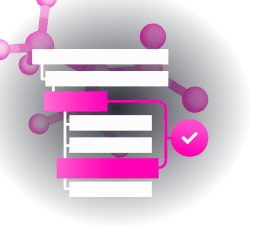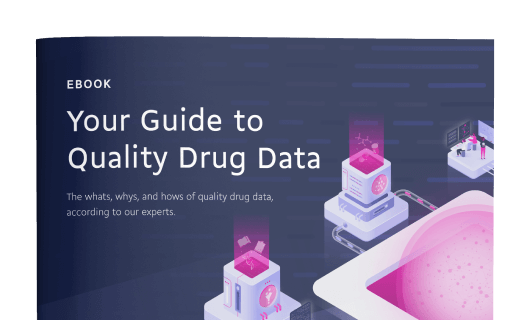Explore a selection of our essential drug information below, or:
Identification
- Summary
Latanoprostene bunod is a prostaglandin analog used to reduce ocular hypertension or treat open-angle glaucoma.
- Brand Names
- Vyzulta
- Generic Name
- Latanoprostene bunod
- DrugBank Accession Number
- DB11660
- Background
Latanoprostene Bunod has been used in trials studying the treatment of Glaucoma, Ocular Hypertension, Open-Angle Glaucoma, Open Angle Glaucoma, and Intraocular Pressure.
As of November 2, 2017 the FDA approved Bausch + Lomb's Vyzulta (latanoprostene bunod opthalmic solution), 0.024% for the indication of reducing intraocular pressure in patients with open-angle glaucoma or ocular hypertension. Latanoprostene bunod is the first prostaglandin analog with one of its metabolites being nitric oxide (NO). The novelty of this agent subsequently lies in the proposed dual mechanism of action that stems from both its prostaglandin F2-alpha analog latanoprost acid metabolite and its ability to donate NO for proposed tissue/cell relaxation effects.
In comparison, both latanoprost and latanoprostene bunod contain a latanoprost acid backbone. Conversely however, latanoprostene bunod integrates an NO-donating moiety in lieu of the isopropyl ester typically found in latanoprost.
- Type
- Small Molecule
- Groups
- Approved, Investigational
- Structure
- Weight
- Average: 507.624
Monoisotopic: 507.283217284 - Chemical Formula
- C27H41NO8
- Synonyms
- Latanoprostene bunod
- External IDs
- BOL-303259-X
- NCX 116
- NCX-116
- PF-3187207
Pharmacology
- Indication
Latanoprostene bunod opthalmic solution is indicated for the reduction of intraocular pressure in patients with open-angle glaucoma or ocular hypertension Label.
 Reduce drug development failure ratesBuild, train, & validate machine-learning modelswith evidence-based and structured datasets.Build, train, & validate predictive machine-learning models with structured datasets.
Reduce drug development failure ratesBuild, train, & validate machine-learning modelswith evidence-based and structured datasets.Build, train, & validate predictive machine-learning models with structured datasets.- Associated Conditions
Indication Type Indication Combined Product Details Approval Level Age Group Patient Characteristics Dose Form Management of Increased intraocular pressure •••••••••••• ••••• •••••••••• •••••••• •• •••••• •••••••••••• - Contraindications & Blackbox Warnings
 Prevent Adverse Drug Events TodayTap into our Clinical API for life-saving information on contraindications & blackbox warnings, population restrictions, harmful risks, & more.Avoid life-threatening adverse drug events with our Clinical API
Prevent Adverse Drug Events TodayTap into our Clinical API for life-saving information on contraindications & blackbox warnings, population restrictions, harmful risks, & more.Avoid life-threatening adverse drug events with our Clinical API- Pharmacodynamics
Upon applying an appropriate dose of latanoprost bunod, reduction in intraocular pressure begins approximately 1 to 3 hours later with a maximum intraocular pressure reduction effect demonstrated after 11 to 13 hours Label.
- Mechanism of action
Open-angle glaucoma (OAG) is a medical condition that is associated with progressive visual field damage and the loss of vision 1.
Occular hypertension (OHT) is considered a key risk factor for OAG and reducing intraocular pressure (IOP) and being able to maintain unique and appropriate target IOPs for various different patients having OHT can delay or prevent the onset of primary OAG or slow the disease progression of established glaucoma 1.
Ordinary physiological IOP results from aqueous humor produced by the ocular ciliary body and its outflow through a) the trabecular meshwork (TM) and Schlemm's canal (SC) in what is called the conventional pathway, and b) the uveoscleral pathway via the ciliary muscle/choroid/sclera in what is refered to as the unconventional pathway 4.
In patients with OHT or OAG there is increased resistance to aqueous humor outflow by way of the TM/SC pathway, which causes increased IOP. This increase in IOP is believed to be the cause of mechanical stress on the posterior structures of the eye which can result in the dysfunction of optic nerve fibers and the destruction of retinal ganglion cells - all of which ultimately contributes to vision loss 4.
As there is no cure for glaucoma, therapeutic management is predominantly focused on minimizing disease progression and clinical sequelae via the reduction and maintainenance of appropriate target IOPs 4,1.
Subsequently, latanoprostene bunod is thought to lower intraocular pressure via a dual mechanism of action since the medication is metabolized into two relevant moieties upon administration: (1) latanoprost acid, and (2) butanediol mononitrate 4,1,5.
As a prostaglandin F2-alpha analog 4, the latanoprost acid moiety operates as a selective PGF2-alpha (FP) receptor agonist 5. Since FP receptors occur in the ciliary muscle, ciliary epithelium, and sclera the latanoprost acid moiety primarily acts in the uveoscleral pathway where it increases the expression of matrix metalloproteinases (MMPs) like MMP-1, -3, and -9 which promote the degradation of collagen types I, III, and IV in the longitudinal bundles of the ciliary musicle and surrounding sclera 5. The resultant extracellular matrix remodeling of the ciliary muscle consequently produces reduced outflow resistance via increased permeability and increased aqueous humor outflow through the uveoscleral route 5.
Conversely, the butanediol mononitrate undergoes further metabolism to NO and an inactive 1,4-butanediol moiety. As a gas that can freely diffuse across plasma membranes, it is proposed that the relaxing effect of NO to induce reductions in the cell volume and contractility of vascular smooth muscle like cells is dependant upon activation of the sGC/cGMP/PKG cascade pathway. NO released from butanediol mononitrate consequently enters the cells of the TM and inner wall of SC, causing decreases in myosin light chain-2 phosphorylation, increased phosphorylation of large-conductance calcium-activated potassium (BKCa) channels, and a subsequent efflux of potassium ions through such BKCa channels. All of these changes serve to decrease the cell contractility and volume, as well as to rearrange the actin cytoskeleton of the TM and SC cells. These biomechanical changes ultimately allow for enhanced conventional outflow of aqueous humor 5.
Target Actions Organism AProstaglandin F2-alpha receptor agonistHumans - Absorption
In a study with 22 healthy subjects monitored for 28 days, there were no quantifiable plasma concentrations of latanoprostene bunod (Lower Limit Of Quantitation, LLOQ, of 10.0 pg/mL) or butanediol mononitrate (LLOQ of 200 pg/mL) post daily dose of one drop bilaterally in the morning on Day 1 and 28 Label.
The mean time of maximum plasma concentration (Tmax) for latanoprost acid was about 5 minutes post dosage on both Day 1 and 28 of therapy Label.
The mean maximum plasma concentrations (Cmax) of latanoprost acid (LLOQ of 30 pg/mL) were 59.1 pg/mL on Day 1 and 28, respectively Label.
- Volume of distribution
Unfortunately there have been no formal ocular distribution studies performed in humans at this time Label.
- Protein binding
Not Available
- Metabolism
Upon topical administration at the ocular surface, latanoprostene bunod undergoes rapid carboxyl ester hydrolysis by endogenous corneal esterases into latanoprost acid and butanediol mononitrate Label.
After the latanoprost acid reaches the systemic circulation, it is largely metabolized by the liver to the 1,2-dinor and 1,2,3,4-tetranor metabolites by way of fatty acid beta-oxidation Label.
The butanediol monohidrate undergoes further metabolism (reduction) to 1,4-butanediol and nitric oxide (NO). Furthermore, this 1,4-butanediol metabolite is further oxidized to succinic acid that is subsequently then primarily taken up as a component in the tricarboxylic acid (TCA) cycle in cellular aerobic respiration Label.
Hover over products below to view reaction partners
- Route of elimination
The latanoprost acid component of latanoprostene bunod is predominantly metabolized by the liver and excreted primarily in the urine Label.
- Half-life
The half-life after application of latanoprostene bunod in rabbits was 1.8 hours in cornea, 2.1 hours in aqueous humor, and 4.6 hours in the iris/ciliary body 5.
- Clearance
Since latanoprost acid plasma concentration dropped below the LLOQ (Lower Limit Of Quantitation) of 30 pg/mL in the majority of study subjects by 15 minutes following ordinary ocular administration, the elimination of latanoprost acid from human plasma is considered rapid Label.
- Adverse Effects
 Improve decision support & research outcomesWith structured adverse effects data, including: blackbox warnings, adverse reactions, warning & precautions, & incidence rates. View sample adverse effects data in our new Data Library!Improve decision support & research outcomes with our structured adverse effects data.
Improve decision support & research outcomesWith structured adverse effects data, including: blackbox warnings, adverse reactions, warning & precautions, & incidence rates. View sample adverse effects data in our new Data Library!Improve decision support & research outcomes with our structured adverse effects data.- Toxicity
There are no available human data for the use of latanoprost bunod during pregnancy to inform any drug associated risks. Use during pregnancy must consider whether any potential benefit to the patient will justify the risk presented to the fetus Label.
There are no data on the presence of latanoprost bunod in human milk, the effects on the breastfed infant, or the effects on milk production. The developmental and health benefits of breastfeeding must be considered along with the mother's potential clinical need for latanoprost bunod and any possible risk to the breastfed infant Label.
Prolonged, continued use of latanoprost bunod 0.024% opthalmic solution is expected to cause increased pigmentation of the iris and eyelid. Such pigmentation is expected to increase for as long as the medication is used. Upon discontinuing the medication, although pigmentation changes of the eyelid tissue may likely reverse, pigmentation changes to the iris is likely permanent. Such pigmentation changes typically present as brown pigmentation spreading and increasing concentrically outward from the pupil. These changes may not be noticeable for several months to years. The long-term effects of increased pigmentation are not known and any prospective patients should be informed of this effect. While usage of the medication can continue in patients who do develop such pigmentation changes they should also be examined regularly Label.
Prolonged, continued use of this medication is also expected to cause changes involving the increased length, thickness, and number of eyelash hairs. These changes are usually reversible upon discontinuation of the medication.
Latanoprost bunod can cause or exacerbate existing intraocular inflammation (iritis or uveitis). Use with caution in patients with a history of or active intraocular inflammation.
As a prostaglanding analog, latanoprost bunod has the potential to cuase macular edema, including cystoid macular edema. Use with caution in aphakic patients, in pseudoaphakic patients with a torn posterior lens capsule, or in patients with with known risk factors for macular edema.
Bacterial keratitis or other eye infections are commonly associated with the use of opthalmic solution containers that have been inadvertently contaminated by patients who have a concurrent corneal disease or a disruption of the ocular epithelial surfaced.
Contact lenses should be removed prior to the use of latanoprost bunod because its benzalkonium chloride preservative can affect or alter contact lenses Label.
The most common adverse reactions obseved in patients treated with latanoprostene bunod during clinical trials were conjuctival hyperemica, eye irritation, eye pain, and installation site pain [FDA Lable].
- Pathways
- Not Available
- Pharmacogenomic Effects/ADRs
- Not Available
Interactions
- Drug Interactions
- This information should not be interpreted without the help of a healthcare provider. If you believe you are experiencing an interaction, contact a healthcare provider immediately. The absence of an interaction does not necessarily mean no interactions exist.
Drug Interaction Integrate drug-drug
interactions in your softwareAceclofenac The therapeutic efficacy of Latanoprostene bunod can be decreased when used in combination with Aceclofenac. Acemetacin The therapeutic efficacy of Latanoprostene bunod can be decreased when used in combination with Acemetacin. Acetylsalicylic acid The therapeutic efficacy of Latanoprostene bunod can be decreased when used in combination with Acetylsalicylic acid. Alclofenac The therapeutic efficacy of Latanoprostene bunod can be decreased when used in combination with Alclofenac. Aminophenazone The therapeutic efficacy of Latanoprostene bunod can be decreased when used in combination with Aminophenazone. - Food Interactions
- No interactions found.
Products
 Drug product information from 10+ global regionsOur datasets provide approved product information including:dosage, form, labeller, route of administration, and marketing period.Access drug product information from over 10 global regions.
Drug product information from 10+ global regionsOur datasets provide approved product information including:dosage, form, labeller, route of administration, and marketing period.Access drug product information from over 10 global regions.- Brand Name Prescription Products
Name Dosage Strength Route Labeller Marketing Start Marketing End Region Image Vyzulta Solution / drops 0.24 mg/1mL Ophthalmic Bausch & Lomb Incorporated 2017-11-02 Not applicable US Vyzulta Solution 0.024 % w/v Ophthalmic Bausch & Lomb Inc 2019-05-17 Not applicable Canada
Categories
- ATC Codes
- S01EE06 — Latanoprostene bunod
- Drug Categories
- Antiglaucoma Preparations and Miotics
- Autacoids
- Biological Factors
- Drugs that are Mainly Renally Excreted
- Eicosanoids
- Fatty Acids
- Fatty Acids, Unsaturated
- Inflammation Mediators
- Lipids
- OATP2B1/SLCO2B1 substrates
- Ophthalmologicals
- Prostaglandin analogs reducing intraocular pressure (IOP)
- Prostaglandins
- Prostaglandins, Synthetic
- Sensory Organs
- Chemical TaxonomyProvided by Classyfire
- Description
- This compound belongs to the class of organic compounds known as prostaglandins and related compounds. These are unsaturated carboxylic acids consisting of a 20 carbon skeleton that also contains a five member ring, and are based upon the fatty acid arachidonic acid.
- Kingdom
- Organic compounds
- Super Class
- Lipids and lipid-like molecules
- Class
- Fatty Acyls
- Sub Class
- Eicosanoids
- Direct Parent
- Prostaglandins and related compounds
- Alternative Parents
- Fatty acid esters / Cyclopentanols / Benzene and substituted derivatives / Alkyl nitrates / Organic nitro compounds / Organic nitric acids and derivatives / Cyclic alcohols and derivatives / Carboxylic acid esters / Monocarboxylic acids and derivatives / Organic zwitterions show 4 more
- Substituents
- Alcohol / Alkyl nitrate / Allyl-type 1,3-dipolar organic compound / Aromatic homomonocyclic compound / Benzenoid / Carbonyl group / Carboxylic acid derivative / Carboxylic acid ester / Cyclic alcohol / Cyclopentanol show 15 more
- Molecular Framework
- Aromatic homomonocyclic compounds
- External Descriptors
- Not Available
- Affected organisms
- Humans and other mammals
Chemical Identifiers
- UNII
- I6393O0922
- CAS number
- 860005-21-6
- InChI Key
- LOVMMUBRQUFEAH-UIEAZXIASA-N
- InChI
- InChI=1S/C27H41NO8/c29-22(15-14-21-10-4-3-5-11-21)16-17-24-23(25(30)20-26(24)31)12-6-1-2-7-13-27(32)35-18-8-9-19-36-28(33)34/h1,3-6,10-11,22-26,29-31H,2,7-9,12-20H2/b6-1-/t22-,23+,24+,25-,26+/m0/s1
- IUPAC Name
- 4-(nitrooxy)butyl (5Z)-7-[(1R,2R,3R,5S)-3,5-dihydroxy-2-[(3R)-3-hydroxy-5-phenylpentyl]cyclopentyl]hept-5-enoate
- SMILES
- O[C@H](CC[C@H]1[C@H](O)C[C@H](O)[C@@H]1C\C=C/CCCC(=O)OCCCCO[N+]([O-])=O)CCC1=CC=CC=C1
References
- General References
- Kawase K, Vittitow JL, Weinreb RN, Araie M: Long-term Safety and Efficacy of Latanoprostene Bunod 0.024% in Japanese Subjects with Open-Angle Glaucoma or Ocular Hypertension: The JUPITER Study. Adv Ther. 2016 Sep;33(9):1612-27. doi: 10.1007/s12325-016-0385-7. Epub 2016 Jul 25. [Article]
- Medeiros FA, Martin KR, Peace J, Scassellati Sforzolini B, Vittitow JL, Weinreb RN: Comparison of Latanoprostene Bunod 0.024% and Timolol Maleate 0.5% in Open-Angle Glaucoma or Ocular Hypertension: The LUNAR Study. Am J Ophthalmol. 2016 Aug;168:250-259. doi: 10.1016/j.ajo.2016.05.012. Epub 2016 May 20. [Article]
- Weinreb RN, Scassellati Sforzolini B, Vittitow J, Liebmann J: Latanoprostene Bunod 0.024% versus Timolol Maleate 0.5% in Subjects with Open-Angle Glaucoma or Ocular Hypertension: The APOLLO Study. Ophthalmology. 2016 May;123(5):965-73. doi: 10.1016/j.ophtha.2016.01.019. Epub 2016 Feb 11. [Article]
- Kaufman PL: Latanoprostene bunod ophthalmic solution 0.024% for IOP lowering in glaucoma and ocular hypertension. Expert Opin Pharmacother. 2017 Mar;18(4):433-444. doi: 10.1080/14656566.2017.1293654. Epub 2017 Feb 20. [Article]
- Garcia GA, Ngai P, Mosaed S, Lin KY: Critical evaluation of latanoprostene bunod in the treatment of glaucoma. Clin Ophthalmol. 2016 Oct 18;10:2035-2050. eCollection 2016. [Article]
- External Links
- PubChem Compound
- 11156438
- PubChem Substance
- 347828030
- ChemSpider
- 9331546
- 1988390
- ChEMBL
- CHEMBL2364612
- ZINC
- ZINC000095598449
- Wikipedia
- Latanoprostene_bunod
- FDA label
- Download (182 KB)
Clinical Trials
- Clinical Trials
Clinical Trial & Rare Diseases Add-on Data Package
Explore 4,000+ rare diseases, orphan drugs & condition pairs, clinical trial why stopped data, & more. Preview package Phase Status Purpose Conditions Count Start Date Why Stopped 100+ additional columns Unlock 175K+ rows when you subscribe.View sample data4 Completed Basic Science Open Angle Glaucoma (OAG) 1 somestatus stop reason just information to hide 4 Withdrawn Treatment Ocular Hypertension 1 somestatus stop reason just information to hide 3 Completed Treatment Glaucoma / Ocular Hypertension 1 somestatus stop reason just information to hide 3 Completed Treatment Ocular Hypertension / Open Angle Glaucoma (OAG) 2 somestatus stop reason just information to hide 2 Completed Screening Intraocular Pressure (IOP) 1 somestatus stop reason just information to hide
Pharmacoeconomics
- Manufacturers
- Not Available
- Packagers
- Not Available
- Dosage Forms
Form Route Strength Solution Ophthalmic 0.024 % w/v Solution Ophthalmic 0.240 mg Solution / drops Ophthalmic 0.24 mg/1mL Solution Ophthalmic 0.24 mg/ml - Prices
- Not Available
- Patents
Patent Number Pediatric Extension Approved Expires (estimated) Region US8058467 No 2011-11-15 2025-01-05 US US7910767 No 2011-03-22 2025-01-05 US US7273946 No 2007-09-25 2025-10-03 US US7629345 No 2009-12-08 2025-01-05 US US6211233 No 2001-04-03 2018-06-17 US
Properties
- State
- Liquid
- Experimental Properties
- Not Available
- Predicted Properties
Property Value Source Water Solubility 0.0032 mg/mL ALOGPS logP 3.94 ALOGPS logP 3.79 Chemaxon logS -5.2 ALOGPS pKa (Strongest Acidic) 14.47 Chemaxon pKa (Strongest Basic) -2.7 Chemaxon Physiological Charge 0 Chemaxon Hydrogen Acceptor Count 7 Chemaxon Hydrogen Donor Count 3 Chemaxon Polar Surface Area 139.36 Å2 Chemaxon Rotatable Bond Count 19 Chemaxon Refractivity 136.66 m3·mol-1 Chemaxon Polarizability 56.95 Å3 Chemaxon Number of Rings 2 Chemaxon Bioavailability 0 Chemaxon Rule of Five No Chemaxon Ghose Filter No Chemaxon Veber's Rule No Chemaxon MDDR-like Rule No Chemaxon - Predicted ADMET Features
- Not Available
Spectra
- Mass Spec (NIST)
- Not Available
- Spectra
- Not Available
- Chromatographic Properties
Collision Cross Sections (CCS)
Adduct CCS Value (Å2) Source type Source [M-H]- 228.62422 predictedDeepCCS 1.0 (2019) [M+H]+ 230.52014 predictedDeepCCS 1.0 (2019) [M+Na]+ 236.34445 predictedDeepCCS 1.0 (2019)
Targets

- Kind
- Protein
- Organism
- Humans
- Pharmacological action
- Yes
- Actions
- Agonist
- General Function
- Prostaglandin f receptor activity
- Specific Function
- Receptor for prostaglandin F2-alpha (PGF2-alpha). The activity of this receptor is mediated by G proteins which activate a phosphatidylinositol-calcium second messenger system. Initiates luteolysis...
- Gene Name
- PTGFR
- Uniprot ID
- P43088
- Uniprot Name
- Prostaglandin F2-alpha receptor
- Molecular Weight
- 40054.1 Da
Transporters
- Kind
- Protein
- Organism
- Humans
- Pharmacological action
- Unknown
- Actions
- Substrate
- General Function
- Sodium-independent organic anion transmembrane transporter activity
- Specific Function
- Mediates the Na(+)-independent transport of organic anions such as taurocholate, the prostaglandins PGD2, PGE1, PGE2, leukotriene C4, thromboxane B2 and iloprost.
- Gene Name
- SLCO2B1
- Uniprot ID
- O94956
- Uniprot Name
- Solute carrier organic anion transporter family member 2B1
- Molecular Weight
- 76709.98 Da
References
- Kraft ME, Glaeser H, Mandery K, Konig J, Auge D, Fromm MF, Schlotzer-Schrehardt U, Welge-Lussen U, Kruse FE, Zolk O: The prostaglandin transporter OATP2A1 is expressed in human ocular tissues and transports the antiglaucoma prostanoid latanoprost. Invest Ophthalmol Vis Sci. 2010 May;51(5):2504-11. doi: 10.1167/iovs.09-4290. Epub 2009 Dec 17. [Article]
Drug created at October 20, 2016 20:38 / Updated at April 23, 2024 11:38

